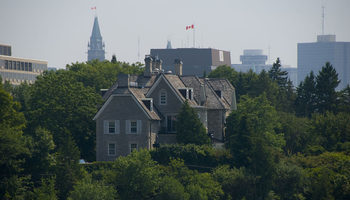
Last fall, Sierra Club Canada Foundation floated an audacious plan to rebuild the Prime Minister’s official residence at 24 Sussex Drive as a net-zero energy heritage retrofit.
The idea caught fire, far faster than we could have imagined. A single blog post generated dozens of letters to newly-elected Prime Minister Justin Trudeau, plus a half-dozen offers of practical support from leading sustainability building experts including a college president with a large green building program, and a researcher who has gone beyond zero net energy buildings to buildings that are net energy positive.
A Big, Complicated Project
In fairness, the 24 Sussex renovation is about more than just being green energy. And that means the NCC has a big job on its hands.
The project will have to respect the history and heritage of the existing building and property, while upgrading the home to be efficient and, frankly, liveable. “The house has changed relatively little since 1950,” the NCC notes, and when I toured the home a little over a decade ago, the neglect was obvious.
The new residence will have to balance space for official functions with private accommodations for prime ministers and their families.
The entire project will unfold under the watchful eye of financial managers determined to keep the cost of the renovation on the right side of the line between appropriate to embarrassing.
And the work will necessarily unfold under the watchful eye of the RCMP security specialists, for whom the family’s safety will outweigh all other concerns.
Which means it would almost be understandable if the NCC set aside the obvious opportunity to turn the Prime Minister’s official residence into a symbol of the smart, tech-savvy, decarbonized Canada we want. Understandable. But not acceptable.
Because it’s 2016. Because Canada’s back. And because the future demands it.
The Green Building This Building Could Be
The easiest way to describe a net-zero building is that it produces as much energy as it consumes across its life cycle. That means designing and operating it to maximize energy-efficiency, then supplying the rest from renewable sources.
It may sound like a costly venture—and once again, we know that every cost attached to this project will be put under a microscope. But last fall, SCCF learned that a net zero design could actually save the government money compared to a conventional rebuild.
“It may be that the improvements in energy efficiency would not only pay back handsomely, but actually reduce capital costs,” low-energy building pioneer Greg Allen told us at the time.
The World Building Design Guide, produced by the U.S. National Institute of Building Sciences, goes into more detail on the different elements of a net-zero design. It distinguishes between buildings that:
- Produce as much energy as they use
- Offset the energy used to produce the energy they use
- Deliver a utility bill of $0 per year, possibly by selling surplus electricity from onsite generation in the form of Renewable Energy Credits
- Use clean energy sources that result in zero emissions carbon dioxide, nitrogen oxides, and other greenhouse gases.
Low-energy builders also take a keen interest in the construction waste their projects generate, knowing that building materials represent a high percentage of the material sent to landfills.
We Are Setting Up A Green Ribbon Committee
Net-zero design is a well enough established discipline that the National Capital Commission can easily make the right move with 24 Sussex Drive. But they’re preoccupied enough with the rest of the project that they may need some guidance along the way. That’s where Sierra is stepping in to assist. We are in the process of putting together a green ribbon advisory committee to provide input to the NCC. Stay tuned for updates on how you can help.
In the meantime DONATE to help Sierra Club Canada Foundation work for a low-carbon Canada, and so many of the other things you care about.
…because it’s 2016! Happy New Year to all.
Sincerely,
Diane Beckett
Interim Executive Director
Sierra Club Canada Foundation

